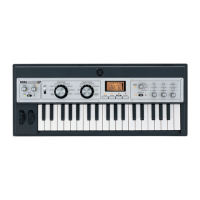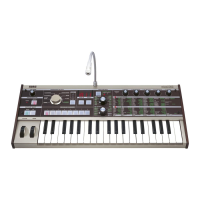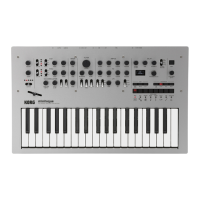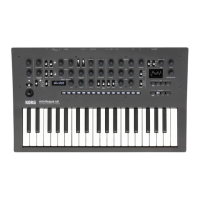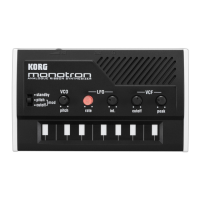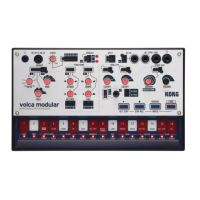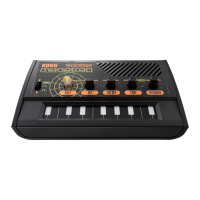Layers, Splits, and Velocity switches
65
Quick StartIntroductionSetupProgram
Combination
Creating Key Splits and Layers
Let’s create a Combi which combines both splits
and layers, like the diagram below:
1. Access the COMBI 0: Play, Prog page.
2. Select a piano sound for Timbre 1, a brass
sound for Timbre 2, and a strings sound for
Timbre 3.
3. Access the COMBI 2: Ed–Timbre Param, MIDI
page.
4. For Timbres 1–3, set Status to INT and MIDI
Channel to Gch (the Global Channel).
5. Access the COMBI 5: Ed–Key Zone, Key page.
6. Set Timbre 1’s Top Key to G9, and its Bottom
Key to C4.
7. Set Timbres 2 and 3 to a Top Key of B3, and a
Bottom Key of C–1.
The piano program will sound when you play a
key above or including C4. The brass program
and strings program will sound when you play
a key below C4.
Key Zone Slope
In addition to “hard” splits, in which the sound
changes abruptly, you can use the “Slope” param-
eters to gradually fade a sound in or out over a
range of keys.
We’ll assume that you are continuing to edit from
the preceding example.
1. Access the COMBI 5: Ed–Key Zone, Key page.
2. In the example above, you could set the
“Bottom Key” of timbre 1 to G3, and set the
“Top Key” of timbre 2 to G4, so that these two
timbres overlap.
3. Access the COMBI 5: Ed–Key Zone, Slope page.
4. Next, if you set the “Bottom Slope” of timbre 1
to 12, and set the “Top Slope” of timbre 2 to 12,
the sound will change gradually instead of
changing suddenly.
5. The COMBI 5: Ed–Key Zone, Review page
shows a graphic indication of the region of keys
(or note data) for which timbres 1–8 will play.
The region that will sound is shown as a line,
and the shaded area indicates the portion
occupied by the slope.
Creating Velocity Switches
Next, let’s create a simple velocity switched Com-
bination, like the diagram below:
1. Access the COMBI 0: Play, Prog page.
2. Select a brass sound for Timbre 1, and a strings
sound for Timbre 2.
3. Access the COMBI 2: Ed–Timbre Param, MIDI
page.
4. For Timbres 1–2, set “Status” to INT and MIDI
Channel to Gch (the Global Channel).
5. Access the COMBI 6: Ed–Vel Zone, Vel page.
6. Set Timbre 1’s Top Velocity to 127, and its
Bottom Velocity to 64.
7. Set Timbre 2 to a Top Velocity of 63, and a
Bottom Velocity of 1.
The strings program will sound when you play
the keyboard softly, and the brass program will
sound when you play strongly.
Program A
Program B
Keyboard X-Fade (keyboard
crossfade):
As you play from low notes to
high notes, the volume of A
will fade out, and the volume
of B will fade in.
C–1 C4 G9B3
PianoTimbre 1
Brass
Timbre 2
Strings
Timbre 3
127
64
63
1
Strings
Velocity
switch
Timbre 1
Timbre 2
Brass
